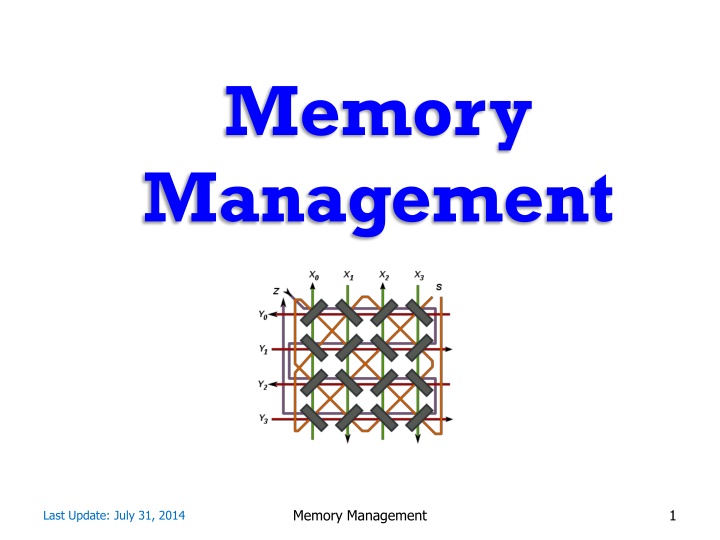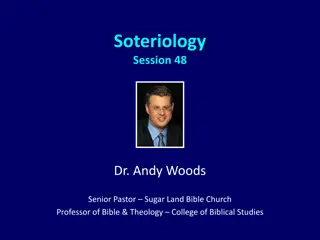
Memory Management in Computer Systems
Explore the concepts of computer memory management, object creation in Java, free list allocation, memory allocation heuristics, and garbage collection. Learn how memory is organized in a computer, stored for data structures, and reclaimed through garbage collection processes.
Download Presentation

Please find below an Image/Link to download the presentation.
The content on the website is provided AS IS for your information and personal use only. It may not be sold, licensed, or shared on other websites without obtaining consent from the author. If you encounter any issues during the download, it is possible that the publisher has removed the file from their server.
You are allowed to download the files provided on this website for personal or commercial use, subject to the condition that they are used lawfully. All files are the property of their respective owners.
The content on the website is provided AS IS for your information and personal use only. It may not be sold, licensed, or shared on other websites without obtaining consent from the author.
E N D
Presentation Transcript
Memory Management Memory Management 1 Last Update: July 31, 2014
Slides copied directly from Andy (And not covered by Jeff)
Computer Memory In order to implement any data structure on an actual computer, we need to use computer memory. Computer memory is organized into a sequence of words, each of which typically consists of 4, 8, or 16 bytes (depending on the computer). These memory words are numbered from 0 to N 1 , where N is the number of memory words available to the computer. The number associated with each memory word is known as its memory address. Memory Management 3 Last Update: July 31, 2014
Object Creation With Java, all objects are stored in a pool of memory, known as the memory heap or Java heap (should not be confused with the heap data structure). Consider what happens when we execute a command such as: w = Widget() A new instance of the class is created and stored somewhere within the memory heap. Memory Management 4 Last Update: July 31, 2014
Free List The storage available in the memory heap is divided into blocks, which are contiguous array-like chunks of memory that may be of variable or fixed sizes. The system must be implemented so that it can quickly allocate memory for new objects. One popular method is to keep contiguous holes of available free memory in a linked list, called the free list. Deciding how to allocate blocks of memory from the free list when a request is made is known as memory management. Memory Management 5 Last Update: July 31, 2014
Memory Management Several heuristics have been suggested for allocating memory from the heap so as to minimize fragmentation. The best-fit algorithm searches the entire free list to find the hole whose size is closest to the amount of memory being requested. The first-fit algorithm searches from the beginning of the free list for the first hole that is large enough. The next-fit algorithm is similar, in that it also searches the free list for the first hole that is large enough, but it begins its search from where it left off previously, viewing the free list as a circularly linked list. The worst-fit algorithm searches the free list to find the largest hole of available memory. Memory Management 6 Last Update: July 31, 2014
Garbage Collection The process of detecting stale objects, de-allocating the space devoted to those objects, and returning the reclaimed space to the free list is known as garbage collection. In order for a program to access an object, it must have a direct or indirect reference to that object. Such objects are live objects. We refer to all live objects with direct reference (that is a variable pointing to them) as root objects. An indirect reference to a live object is a reference that occurs within the state of some other live object, such as a cell of a live array or field of some live object. Memory Management 7 Last Update: July 31, 2014
Mark-Sweep Algorithm In the mark-sweep garbage collection algorithm, we associate a mark bit with each object that identifies whether that object is live. When we determine at some point that garbage collection is needed, we suspend all other activity and clear the mark bits of all the objects currently allocated in the memory heap. We then trace through the active namespaces and we mark all the root objects as live. We must then determine all the other live objects the ones that are reachable from the root objects. To do this efficiently, we can perform a depth-first search on the directed graph that is defined by objects reference other objects. Memory Management 8 Last Update: July 31, 2014
Memory Hierarchies Computers have a hierarchy of different kinds of memories, which vary in terms of their size and distance from the CPU. Closest to the CPU are the internal registers. Access to such locations is very fast, but there are relatively few such locations. At the second level in the hierarchy are the memory caches. At the third level in the hierarchy is the internal memory, which is also known as main memory or core memory. Another level in the hierarchy is the external memory, which usually consists of disks. Memory Management 9 Last Update: July 31, 2014
Virtual Memory Virtual memory consists of providing an address space as large as the capacity of the external memory, and of transferring data in the secondary level into the primary level when they are addressed. Virtual memory does not limit the programmer to the constraint of the internal memory size. The concept of bringing data into primary memory is called caching, and it is motivated by temporal locality. By bringing data into primary memory, we are hoping that it will be accessed again soon, and we will be able to respond quickly to all the requests for this data that come in the near future. Memory Management 10 Last Update: July 31, 2014
Page Replacement Strategies When a new block is referenced and the space for blocks from external memory is full, we must evict an existing block. There are several such page replacement strategies, including: FIFO LIFO Random Memory Management 11 Last Update: July 31, 2014
The Random Strategy Choose a page at random to evict from the cache. The overhead involved in implementing this policy is an O(1) additional amount of work per page replacement. Still, this policy makes no attempt to take advantage of any temporal locality exhibited by a user s browsing. Memory Management 12 Last Update: July 31, 2014
The FIFO Strategy FIFO is quite simple to implement, as it only requires a queue Q to store references to the pages in the cache. Pages are enqueued in Q when they are referenced, and then are brought into the cache. When a page needs to be evicted, the computer simply performs a dequeue operation on Q to determine which page to evict. Thus, this policy also requires O(1) additional work per page replacement. Moreover, it tries to take some advantage of temporal locality. Memory Management 13 Last Update: July 31, 2014
The LRU Strategy LRU evicts the page that was least-recently used. From a policy point of view, this is an excellent approach, but it is costly from an implementation point of view. Implementing the LRU strategy requires the use of an adaptable priority queue Q that supports updating the priority of existing pages. If Q is implemented with a sorted sequence based on a linked list, then the overhead for each page request and page replacement is O(1). Memory Management 14 Last Update: July 31, 2014
B-Trees Memory Management 15 Last Update: July 31, 2014
Computer Memory In order to implement any data structure on an actual computer, we need to use computer memory. Computer memory is organized into a sequence of words, each of which typically consists of 4, 8, or 16 bytes (depending on the computer). These memory words are numbered from 0 to N 1 , where N is the number of memory words available to the computer. The number associated with each memory word is known as its memory address. Memory Management 16 Last Update: July 31, 2014
Disk Blocks Consider the problem of maintaining a large collection of items that does not fit in main memory, such as a typical database. In this context, we refer to the external memory as divided into blocks, which we call disk blocks. The transfer of a block between external memory and primary memory is a disk transfer or I/O. There is a great time difference that exists between main memory accesses and disk accesses Thus, we want to minimize the number of disk transfers needed to perform a query or update. We refer to this count as the I/O complexity of the algorithm involved. Memory Management 17 Last Update: July 31, 2014
(a,b) Trees To reduce the number of external-memory accesses when searching, we can represent a map using a multiway search tree. This approach gives rise to a generalization of the (2,4) tree data structure known as the (a,b) tree. An (a,b)tree is a multiway search tree such that each node has between aand bchildren and stores between a 1 and b 1 entries. By setting the parameters a and b appropriately with respect to the size of disk blocks, we can derive a data structure that achieves good external-memory performance. Memory Management 18 Last Update: July 31, 2014
Definition An (a,b) tree, where parameters a and b are integers such that 2 a (b+1)/2, is a multiway search tree T with the following additional restrictions: Size Property: Each internal node has at least a children, unless it is the root, and has at most b children. Depth Property: All external nodes have the same depth. Memory Management 19 Last Update: July 31, 2014
Height of an (a,b) Tree Memory Management 20 Last Update: July 31, 2014
Searches and Updates The search algorithm in an (a,b) tree is exactly like the one for multiway search trees. The insertion algorithm for an (a,b) tree is similar to that for a (2,4) tree. An overflow occurs when an entry is inserted into a b-node w, which becomes an illegal (b+1)-node. To remedy an overflow, we split node w by moving the median entry of w into the parent of w and replacing w with a (b+1)/2-node w and a (b+1)/2- node w. Removing an entry from an (a,b) tree is similar to what was done for (2,4) trees. An underflow occurs when a key is removed from an a-node w, distinct from the root, which causes w to become an (a 1)-node. To remedy an underflow, we perform a transfer with a sibling of w that is not an a-node or we perform a fusion of w with a sibling that is an a-node. Memory Management 21 Last Update: July 31, 2014
B-Trees A version of the (a,b) tree data structure, which is the best-known method for maintaining a map in external memory, is a B-tree. A B-tree of order d is an (a,b) tree with a = d/2and b = d. Memory Management 22 Last Update: July 31, 2014
I/O Complexity FACT: A B-tree with n entries has I/O complexity ? log? ? for search or update operation, and uses ? ?/? blocks, where ? is the size of a block. Proof: Each time we access a node to perform a search or an update operation, we need only perform a single disk transfer. Each search or update requires that we examine at most O(1) nodes for each level of the tree. Memory Management 23 Last Update: July 31, 2014
Summary Memory Management Object creation Garbage collection Mark-Sweep algorithm Memory hierarchies Virtual memory Page replacement strategies: oFIFO, LRU, Random B-Trees (a, b) Trees Memory Management 24 Last Update: July 31, 2014
Memory Management 25 Last Update: July 31, 2014




















